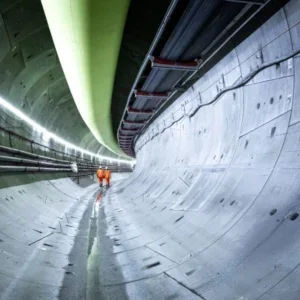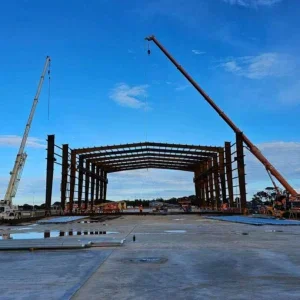In what is believed to be the highest valued active construction project in Belgium, the first of two Herrenknecht Mixshield TBMs, named ‘Wiske’, recently broke through in the twin-bore Liefkenshoek Tunnel to the west of Antwerp under the River Escaut (a tributary of the Schelde) and other waterways serving the docks.
A design-build contracting joint venture, Locobouw, consisting of Vinci Construction Grands Projets (25 per cent), CFE subsidiary MBG (25 per cent), BAM – CEI-de Meyer (25 per cent) and BAM Wayss & Freytag (25 percent) have driven Wiske nearly 6km at rates of up to 45m a day since launch on 26 March last year. The second TBM, called ‘Scaunulleke’, actually began tunnelling first on 8 February 2010, and is currently expected to break through at the end of July. Normal work is carried out 24h a day, seven days a week.
The private-pubic-partnership (PPP) project is designed to speed up rail freight movements between the left (Ploegweg shaft) and right banks (Kruisweg) of the major European port of Antwerp. Infrabel, the Belgian railway infrastructure manager, granted the project concession in November 2008 to the Locorail consortium consisting of Vinci Concessions (25 per cent), CFE (25 per cent part owned by Vinci) and the Dutch BAM PPP (50 per cent). The PPP contract will last 42 years and has a total value of EUR 841M (USD 1218M) including design, financing, construction (worth EUR 690M – USD 1000M) and maintenance in operation for 38 years. Remuneration to the concessionaire will be in the form of a quarterly fee amounting to about EUR 50M (USD 72M) a year based on tunnel availability.
The twin 6-km tunnels are part of a 16.2-km dual-track link between the South Siding west of Waaslandhaven and Antwerp North near the Dock Canal B1-B2. The new route will reduce by 22km the distances to be covered by freight trains and cater for expanding goods traffic through the port. The project also includes construction of the surface track and refurbishment of the old, but unused, Beveren Tunnel.
The TBMs each have a cutting diameter of 8.39m and a cutterhead power of 1100kW to tackle clay and sands. On lining with a precast ring of seven segments and a key the internal tunnel diameter is 7.30m. Over 53 000 segments are being produced in a plant nearby for delivery by rail to a holding yard. Each ring is 1.8m wide.
A full report on the project, due for completion late 2013 for operation from mid-2014, will appear in the July issue of T&TI.







